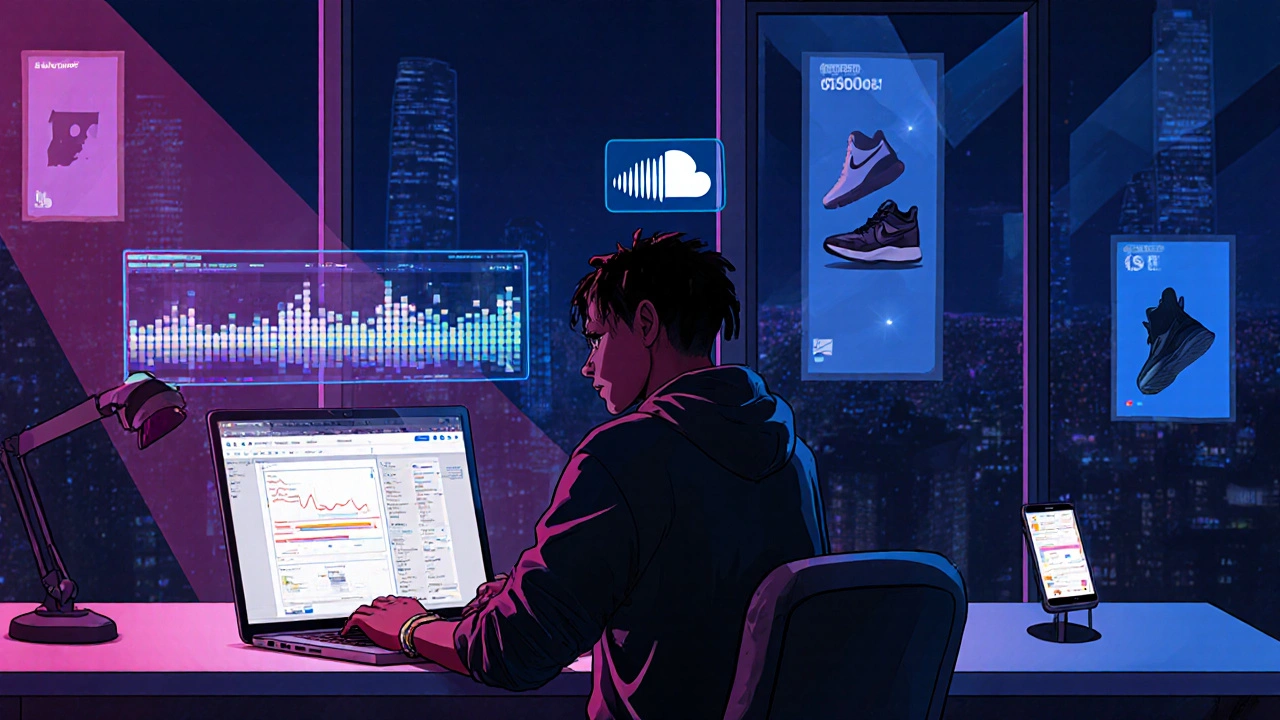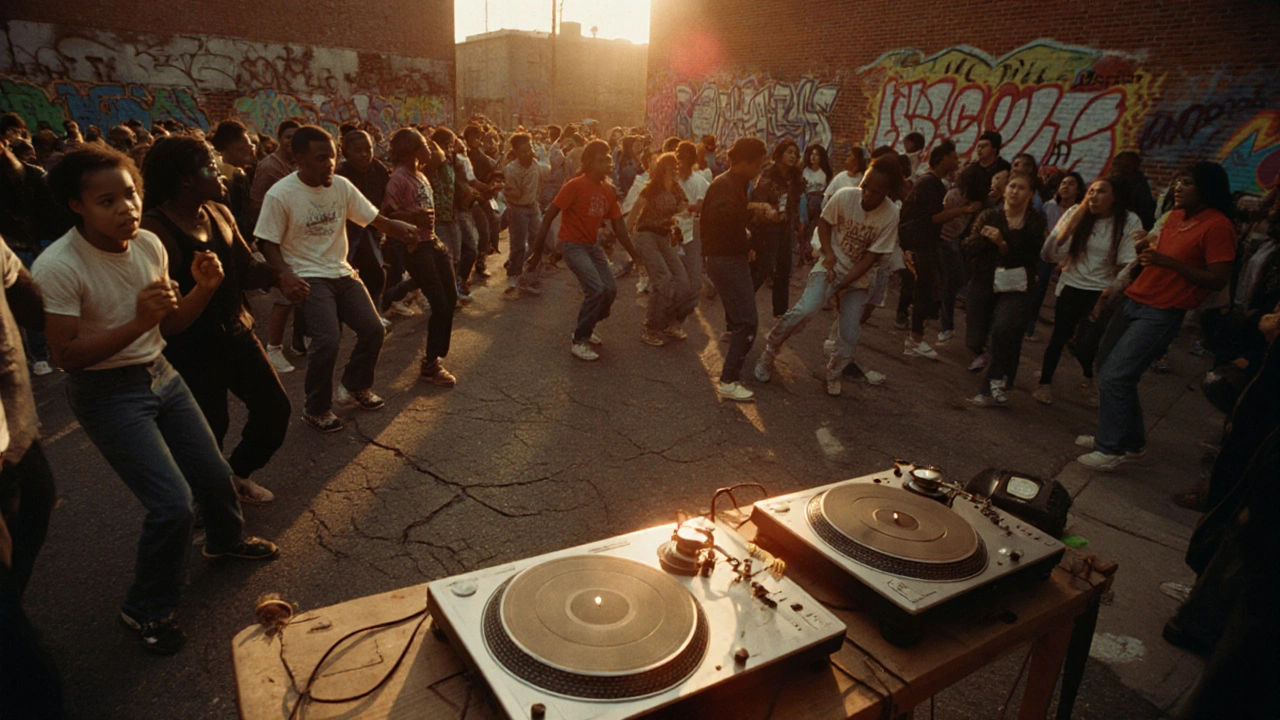Hip Hop Business Model Revenue Calculator
How the Models Compare
Label funds production, marketing, and distribution. Artist receives advance, but label recoups costs before artist sees royalties. Typically 85/15 split after recoupment.
Artist self-funds or uses crowdfunding. Retains 100% of masters. Receives direct streaming royalties (≈55% of revenue) plus revenue from other sources.
Input Your Data
Estimated Earnings
Key Insight: Independent artists earn $0 more per month than traditional label deals at 100,000 streams when considering all revenue streams.
Hip Hop music is a cultural movement that started in the Bronx in the 1970s and has grown into a global force reshaping how records are made, marketed, and consumed. If you’ve noticed more playlists dominated by rap beats, younger artists dropping surprise albums, and brands chasing viral dance challenges, you’re witnessing the same wave that has turned the whole Music Industry on its head.
From Block Parties to Global Charts
The early days of hip hop were about community-DJ battles, MC freestyle, and break‑dancing sessions that turned vacant lots into live studios. Those grassroots roots taught a simple rule: if you can make a crowd move, you’ve got a product. Fast‑forward to 2025, and that rule underpins billions of streams, with hip hop accounting for over 30% of global music consumption according to the International Federation of the Phonographic Industry (IFPI).
Breaking the Gatekeeper Model
Traditional record labels once acted as the only gatekeepers. They funded studios, owned distribution channels, and decided which songs hit radio. Hip hop flipped that script. Early mixtapes were pressed on cassette, handed out on street corners, and later uploaded to sites like Datpiff. Those DIY releases proved that artists could bypass label approval, build fanbases, and negotiate better deals. Today, platforms like SoundCloud and Audiomack let an emerging rapper drop a track, gain a million plays, and attract a label offer on their own terms.
Sampling: The Sound‑Collage Engine
Sampling-lifting snippets from funk, soul, and jazz-has always been hip hop’s signature. It’s more than a creative trick; it’s a technology‑driven business model. The legal landscape forced artists to clear samples, spawning a new niche of rights‑clearance firms that specialize in hip hop. This ecosystem created jobs for producers, engineers, and lawyers, turning a once‑underground practice into a multibillion‑dollar revenue stream.
Independent Artists and the New Label Playbook
Because hip hop proved you can succeed without a major label, a wave of independent artists now run their own micro‑labels. They use distribution services like DistroKid or TuneCore to push music to Spotify, Apple Music, and Amazon Music with a few clicks. The result? More than 45% of the top 20 Billboard Hot 100 songs in 2024 were released by artists who owned their masters.

Social Media & Viral Momentum
Platforms such as TikTok, Instagram Reels, and YouTube Shorts have become the newest A‑R sections. A 15‑second hook can spark a dance challenge that rakes in millions of streams. When Lil Nas X turned “Old Town Road” into a meme, the track vaulted from a SoundCloud upload to a 19‑week run at number 1. Labels now hire “trend strategists” whose job is to turn a viral moment into chart‑topping revenue.
Streaming Economics Re‑Engineered by Hip Hop
Hip hop’s dominance forced streaming services to rethink royalty formulas. In 2023, Spotify introduced the “Hip Hop Boost” program, giving higher per‑stream payouts for tracks that meet certain engagement thresholds. This move reflects the genre’s higher average listening time per user-hip hop listeners spend 2.5× more minutes per session than the average pop fan.
Fashion, Branding, and Cross‑Industry Partnerships
The visual culture of hip hop-from streetwear to sneaker collaborations-has turned musicians into brand ambassadors. Partnerships between artists and companies like Nike, Adidas, and Gucci now generate revenue streams rivaling album sales. The “Don’t Judge Me” line by a rising Australian rapper sold out within hours, illustrating how hip hop’s aesthetic drives consumer behavior far beyond music.
Technology Trends: AI Beats and NFTs
Artificial‑intelligence beat generators, such as BeatBots, let producers craft instrumentals in seconds. While some purists argue this dilutes authenticity, many artists embrace AI to accelerate workflow and experiment with new sounds. Simultaneously, NFTs give rappers a way to sell exclusive tracks or concert experiences directly to fans, creating a new “collectible” market that mirrors sneaker drops.

Comparison: Traditional Label Model vs Hip Hop Independent Model
| Aspect | Traditional Label Deal | Hip Hop Independent Model |
|---|---|---|
| Funding Source | Label advances (often recoupable) | Artist self‑funds or uses crowdfunding |
| Rights Ownership | Label typically owns master recordings | Artist retains 100% of masters |
| Revenue Split | Typical 85/15 (label/artist) after recoupment | Direct streaming royalties (≈55% to artist) |
| Marketing Reach | National radio, TV, print | Social media, viral challenges, influencer partnerships |
| Time to Release | Months to years for album rollout | Weeks or days - surprise drops are common |
Checklist: How to Leverage Hip Hop’s Engine for Your Music Career
- Build a strong social‑media presence; focus on short‑form video.
- Release a high‑quality single before a full album to test audience reaction.
- Consider sampling legally; use clearance services to avoid lawsuits.
- Distribute through digital aggregators that offer fast payouts.
- Partner with fashion or street‑wear brands for cross‑promotion.
- Explore AI beat tools for faster production cycles.
- Monitor streaming analytics to qualify for platform bonus programs.
Future Outlook: Hip Hop as the Blueprint for All Genres
While hip hop leads the charge, its playbook is being adopted by pop, country, and even classical musicians. The blend of DIY distribution, data‑driven marketing, and cultural branding is no longer a niche-it’s the new normal. Expect to see more hybrid deals, AI‑enhanced songwriting, and immersive fan experiences built around the hip hop model.
Wrap‑Up
Hip hop didn’t just add a new sound to the world; it rewired the entire music‑business engine. From the streets of New York to the studios of Perth, its influence is evident wherever beats drop, streams climb, and fans engage. If you’re an artist, label executive, or marketer, understanding this revolution isn’t optional-it’s essential for staying relevant in 2025 and beyond.
Why is hip hop more dominant on streaming platforms than other genres?
Hip hop listeners spend more minutes per session and often favor playlists and algorithmic discovery, which signals platforms to push the genre higher. Additionally, the genre’s strong social‑media presence drives viral spikes that translate into streaming bursts.
How do independent hip hop artists fund their releases without label advances?
Many use crowdfunding platforms like Kickstarter, Patreon, or direct fan subscriptions. Others reinvest earnings from live shows, merch, and brand deals. Digital distributors also offer low‑cost entry points for global release.
What’s the legal process for clearing a sample in a hip hop track?
You must identify the original recording’s owners, negotiate a licensing fee, and obtain written permission. Companies like Hip Hop Clearance specialize in handling these negotiations for emerging artists.
Can AI‑generated beats be copyrighted?
Current U.S. law requires a human author for copyright protection. If an artist selects, edits, or arranges AI‑generated material, they can claim authorship of the resulting composition.
What role do fashion collaborations play in a rapper’s revenue?
Fashion drops often generate upfront licensing fees, profit‑sharing on sales, and increased brand visibility, which can boost streaming numbers and concert ticket demand.

